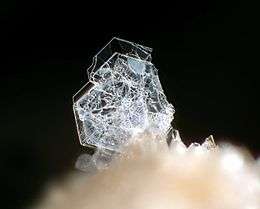Tridymite
Tridymite is a high-temperature polymorph of silica and usually occurs as minute tabular white or colorless pseudo-hexagonal crystals, or scales, in cavities in felsic volcanic rocks. Its chemical formula is SiO2. Tridymite was first described in 1868 and the type location is in Hidalgo, Mexico. The name is from the Greek tridymos for triplet as tridymite commonly occurs as twinned crystal trillings[1] (compound crystals comprising three twinned crystal components).
| Tridymite | |
|---|---|
 tabular tridymite crystals from Ochtendung, Eifel, Germany | |
| General | |
| Category | Oxide mineral (or tectosilicate), quartz group |
| Formula (repeating unit) | SiO2 |
| Strunz classification | 4.DA.10 |
| Crystal system | Orthorhombic (α-tridymite) |
| Crystal class | Disphenoidal (222) H-M symbol: (222) |
| Space group | C2221 |
| Identification | |
| Formula mass | 60.08 g/mol |
| Color | Colorless, white |
| Crystal habit | Platy – sheet forms |
| Cleavage | {0001} indistinct, {1010} imperfect |
| Fracture | Brittle – conchoidal |
| Mohs scale hardness | 7 |
| Luster | Vitreous |
| Streak | white |
| Specific gravity | 2.25–2.28 |
| Optical properties | Biaxial (+), 2V=40–86° |
| Refractive index | nα=1.468–1.482 nβ=1.470–1.484 nγ=1.474–1.486 |
| Birefringence | δ < 0.004 |
| Pleochroism | Colorless |
| Other characteristics | non-radioactive, non-magnetic; fluorescent, short UV=dark red |
| References | [1][2] |
Structure


Tridymite can occur in seven crystalline forms. Two of the most common at standard pressure are known as α and β. The α-tridymite phase is favored at elevated temperatures (>870 °C) and it converts to β-cristobalite at 1470 °C.[3][4] However, tridymite does usually not form from pure β-quartz, one needs to add trace amounts of certain compounds to achieve this.[5] Otherwise the β-quartz-tridymite transition is skipped and β-quartz transitions directly to cristobalite at 1050 °C without occurrence of the tridymite phase.
| Name | Symmetry | Space group | T (°C) |
|---|---|---|---|
| HP (β) | Hexagonal | P63/mmc | 460 |
| LHP | Hexagonal | P6322 | 400 |
| OC (α) | Orthorhombic | C2221 | 220 |
| OS | Orthorhombic | 100–200 | |
| OP | Orthorhombic | P212121 | 155 |
| MC | Monoclinic | Cc | 22 |
| MX | Monoclinic | C1 | 22 |
In the table, M, O, H, C, P, L and S stand for monoclinic, orthorhombic, hexagonal, centered, primitive, low (temperature) and superlattice. T indicates the temperature, at which the corresponding phase is relatively stable, though the interconversions between phases are complex and sample dependent, and all these forms can coexist at ambient conditions.[4] Mineralogy handbooks often arbitrarily assign tridymite to the triclinic crystal system, yet use hexagonal Miller indices because of the hexagonal crystal shape (see infobox image).[1]
Mars
In December 2015, the team behind NASA's Mars Science Laboratory announced the discovery of large amounts of tridymite in Marias Pass on the slope of Aeolis Mons, popularly known as Mount Sharp, on the planet Mars.[6] This discovery was unexpected given the rarity of the mineral on Earth and the apparent lack of volcanic activity where it was discovered, and at the time of discovery no explanation for how it was formed was forthcoming. Its discovery was serendipitous: two teams, responsible for two different instruments on the Curiosity rover, both happened to report what in isolation were relatively uninteresting findings related to their instruments: the ChemCam team reported a region of high silica while the DAN team reported high neutron readings in what turned out to be the same area. Neither team would have been aware of the other's findings had it not been for a fortuitous Mars conjunction in July 2015, during which the various international teams took advantage of the downtime to meet in Paris and discuss their scientific findings. DAN's high neutron readings would normally have been interpreted as meaning the region was hydrogen-rich, and ChemCam's high-silica readings were not surprising given the ubiquity of silica-rich deposits on Mars, but taken together it was clear that further study of the region was needed. Following conjunction, NASA directed the Curiosity rover back to the area where the readings had been taken and discovered that large amounts of tridymite were present. How they were formed remains a mystery.[7]
See also
| Wikisource has original text related to this article: |
References
- Anthony, John W.; Bideaux, Richard A.; Bladh, Kenneth W.; Nichols, Monte C. (eds.). "Tridymite". Handbook of Mineralogy (PDF). III (Halides, Hydroxides, Oxides). Chantilly, VA, US: Mineralogical Society of America. ISBN 0-9622097-2-4. Retrieved December 5, 2011.
- Mindat
- Kuniaki Kihara; Matsumoto T.; Imamura M. (1986). "Structural change of orthorhombic-I tridymite with temperature: A study based on second-order thermal-vibrational parameters". Zeitschrift für Kristallographie. 177: 27–38. Bibcode:1986ZK....177...27K. doi:10.1524/zkri.1986.177.1-2.27.
- William Alexander Deer; R. A. Howie; W. S. Wise (2004). Rock-Forming Minerals: Framework Silicates: Slica Minerals, Feldspathoids and the Zeolites. Geological Society. pp. 22–. ISBN 978-1-86239-144-4. Retrieved 2 January 2012.
- Heaney, P. J. (1994). "Structure and chemistry of the low-pressure silica polymorphs". Reviews in Mineralogy. 29.
- Chang, Kenneth (December 17, 2015). "Mars Rover Finds Changing Rocks, Surprising Scientists". New York Times. Retrieved December 22, 2015.
- Lakdawalla, Emily (December 18, 2015). "Curiosity stories from AGU: The fortuitous find of a puzzling mineral on Mars, and a gap in Gale's history". The Planetary Society. Retrieved December 21, 2015.
External links
| Wikimedia Commons has media related to Tridymite. |